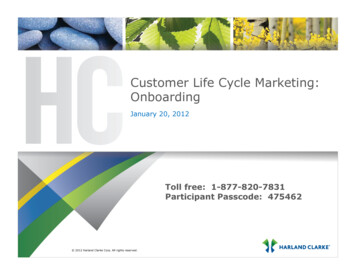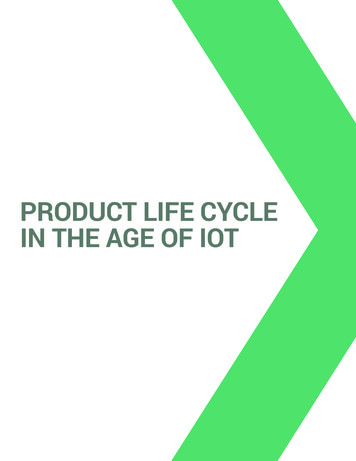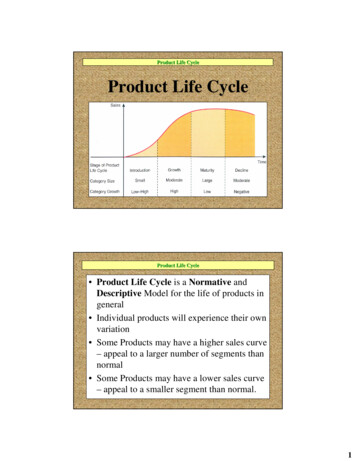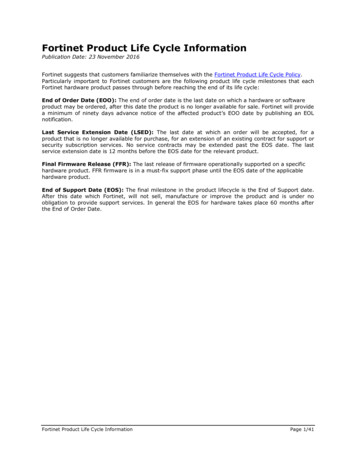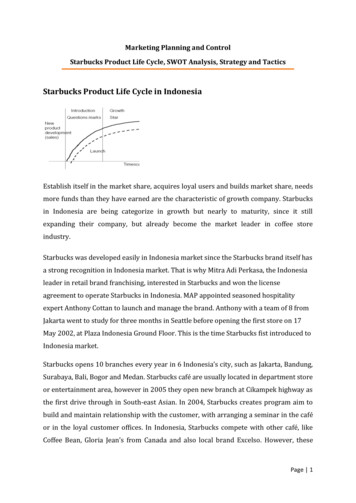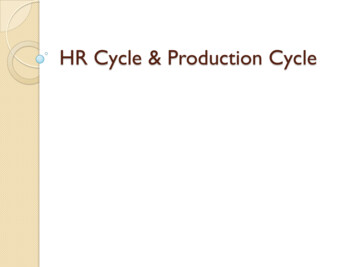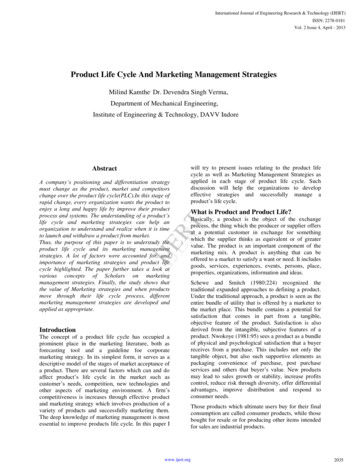
Transcription
International Journal of Engineering Research & Technology (IJERT)ISSN: 2278-0181Vol. 2 Issue 4, April - 2013Product Life Cycle And Marketing Management StrategiesMilind Kamthe, Dr. Devendra Singh Verma,Department of Mechanical Engineering,Institute of Engineering & Technology, DAVV IndoreAbstractWhat is Product and Product Life?Basically, a product is the object of the exchangeprocess, the thing which the producer or supplier offersat a potential customer in exchange for somethingwhich the supplier thinks as equivalent or of greatervalue. The product is an important component of themarketing mix. A product is anything that can beoffered to a market to satisfy a want or need. It includesgoods, services, experiences, events, persons, place,properties, organizations, information and ideas.IIJJEERRTTA company’s positioning and differentiation strategymust change as the product, market and competitorschange over the product life cycle(PLC).In this stage ofrapid change, every organization wants the product toenjoy a long and happy life by improve their productprocess and systems. The understanding of a product’slife cycle and marketing strategies can help anorganization to understand and realize when it is timeto launch and withdraw a product from market.Thus, the purpose of this paper is to understudy theproduct life cycle and its marketing managementstrategies. A lot of factors were accounted for, andimportance of marketing strategies and product lifecycle highlighted. The paper further takes a look atvarious concepts of Scholars on marketingmanagement strategies. Finally, the study shows thatthe value of Marketing strategies and when productsmove through their life cycle process, differentmarketing management strategies are developed andapplied as appropriate.will try to present issues relating to the product lifecycle as well as Marketing Management Strategies asapplied in each stage of product life cycle. Suchdiscussion will help the organizations to developeffective strategies and successfully manage aproduct’s life cycle.IntroductionThe concept of a product life cycle has occupied aprominent place in the marketing literature, both asforecasting tool and a guideline foe corporatemarketing strategy. In its simplest form, it serves as adescriptive model of the stages of market acceptance ofa product. There are several factors which can and doaffect product’s life cycle in the market such ascustomer’s needs, competition, new technologies andother aspects of marketing environment. A firm’scompetitiveness is increases through effective productand marketing strategy which involves production of avariety of products and successfully marketing them.The deep knowledge of marketing management is mostessential to improve products life cycle. In this paper Iwww.ijert.orgSchewe and Smitch (1980:224) recognized thetraditional expanded approaches to defining a product.Under the traditional approach, a product is seen as theentire bundle of utility that is offered by a marketer tothe market place. This bundle contains a potential forsatisfaction that comes in part from a tangible,objective feature of the product. Satisfaction is alsoderived from the intangible, subjective features of aproduct. Nwokoye (1981:95) sees a product as a bundleof physical and psychological satisfaction that a buyerreceives from a purchase. This includes not only thetangible object, but also such supportive elements aspackaging convenience of purchase, post purchaseservices and others that buyer’s value. New productsmay lead to sales growth or stability, increase profitscontrol, reduce risk through diversity, offer differentialadvantages, improve distribution and respond toconsumer needs.Those products which ultimate users buy for their finalconsumption are called consumer products, while thosebought for resale or for producing other items intendedfor sales are industrial products.2035
International Journal of Engineering Research & Technology (IJERT)ISSN: 2278-0181Vol. 2 Issue 4, April - 2013Product Life- The definition of product life is contextdependent as well as user-dependent, E.g., for acustomer the product life is the period of time thatshe/he uses it(e.g. from purchasing until it is disposedof). In contrast to this, the product life is normallylonger for the producing compony; it starts with theideas of a product and concludes with the end of theproduction with the end of the service period for theproduct (Sendler2009).The Product Life Cycle (PLC)The product life cycle is the period of time over whichan item is developed, brought to market and eventuallyremoved from the market. It is an important tool foranalysis and planning of the marketing mix activity.According to Wells et al.(1995:96), product life cycle isbased on a metaphor that treats products as people andassumes they are born (introduction) ,develop (grow),age (mature), and die (decline). To Morden (1991:240),the product life cycle represents recognition of the factthat most products will only have a finite market lifebe it short as in the case of fashion goods or long as inthe case of certain type of industrial equipment.Source: William D.This cycle varies according to industry,product, technology, and market. The productlife cycle is divided into 5 stages:1.Development stage: The developmentstage of the product life cycle occurswhen a corporation finds and develops anew product idea. A product is generallyundergoing several changes involving alot of money and time duringdevelopment, before it is exposed totarget customers via test market. At thisstage, sales are zero and revenues arenegative.2.Introduction stage: The introduction stageof the product life cycle occurs when aproduct is first introduced to its targetmarket. Large expenditure on promotionand advertising is common. A corporationmust be prepared to spend a lot of moneyand get only a small proportion of thatback. At this stage, sales are low,production costs tend to be high and profitis negative or very low.3.Growth stage: The growth stage of theproduct life cycle occurs when demandfor the new product starts increasingrapidly. This is the right time to focus onincreasing the market share becauseinnovators move from the trial to repeatpurchase if they are satisfied with theproduct though innovators may influenceothers by word of-mouth, which is oftenconsidered the most effective mode ofcommunication. A new growing marketalerts the competition’s attention. At thisstage, sales are rise, revenues increase andprofit rise.IIJJEERRTTKotler (2000:303) see the concept as implying thefollowing:1.Products have a limited life.2.Product sales pass through distinct , and problems to the seller.3.Profits rise and fall at different stages of theproduct life l, manufacturing, purchasing, andhuman resources strategies in each life cyclestages.The product life cycle is the concept that a product goesthrough several stages in the course of its life:1.Product development stage.2.Product introduction stage.3.Product growth stage.4.Product maturity stage.5.Product decline stage.www.ijert.org2036
International Journal of Engineering Research & Technology (IJERT)ISSN: 2278-0181Vol. 2 Issue 4, April - 20134.5.Maturity stage: The maturity stage of theproduct life cycle occurs when demandshave reached its planned or unplannedpeak, and the percentage that it’s evergoing to buy the product has beenreached. This stage of life cycle is thelongest phase for most products.Competition is most intense during thisstage. At this stage, sales reach peak, andmarket share may be high.Decline stage: The decline stage ofproduct life cycle occurs when salescontinue a strong downward drift andprofits erode rapidly toward the zeropoint. The typical reason for a productdecline is the entry of new productscoupled with decreases consumer interestin specific product.What is Marketing?1. Product- The product (or service) that the customerobtains2. Price- How much the customer pays for the product?3. Place- How the product is distributed to thecustomer.4. Promotion- How the customer is found andpersuaded to buy the product.Marketing-mix decisions must be made for influencingthe trade channels as well as the final consumers.Marketing MixProductProductVarietyQualityIIJJEERRTTAccording to American Marketing Association,Marketing is the process of planning and executing theconception, pricing, promotion, and distribution ofideas, goods, service to create exchanges that satisfyindividual and organizational goals.Kotler1980, Marketing is the human activity directed atsatisfying human needs and wants through an exchangeprocess.While kotler1991, Marketing is a social and managerialprocess by which individuals and groups obtain whatthey want and need through creating, offering andexchanging products of value with others.According to The Chartered Institute of Marketing,Marketing is the management process that identifies,anticipates and satisfies customer requirementsprofitablyThe core marketing concepts is:1. Target markets and segmentation.2. Marketplace, market space and metamarket.3. Needs, wants and demand.4. Marketers & prospects.5. Product offering and brand.6. Value and satisfaction.7. Relationship and network.8. Marketing channels.9. Supply chain.10. Competition.11. Marketing environment.12. Marketing program.target market. McCarthy classified these tools into fourbroad groups that he called the four Ps of Sales dvertisingBrand NamePackagingPlaceList Marketing MixThe marketing mix is the set of marketing tools thefirm uses to pursue its marketing objectives in thewww.ijert.orgProduct Life Cycle and Marketing StrategyThe introductory period is characterized by heavypromotion aimed at building up primary demand; priceis relatively unimportant. During the growth phase,more competition appears and there is an increasingpressure on price. Promotional expenditures decline inrelation to sales; there is a shift to completion on the2037
International Journal of Engineering Research & Technology (IJERT)ISSN: 2278-0181Vol. 2 Issue 4, April - 2013basis of brands and specific features. As the productenters maturity, there is increasing product brandcompetition, promotional expenditures and price tendto stabilize, manufactures begin efforts to extend lifecycles and new brands may appear. Finally, in thedecline phase, further declines in price and promotionalexpenditures can be expected.the product life cycle stages as price becomesan increasingly important completive weapon,especially at the late stages of growth andthroughout the maturity and decline. Indetermining the product’s price strategy, notonly the introductory price should beconsidered, but also what the next move mightbe, being alternative competitive actions.Some authors have provided specific recommendationsfor marketing strategies at various stages of the productlife cycle. Some of the more commonrecommendations are:2.3.4.Advertising- According to Forrester (1961), inthe introductory stage, advertising informscustomers about the existence, advantages,and uses of new products. During the growthstage, advertising stresses the merits of theproducts compared to competing products. Inthe maturity phase, advertising attempts tocreate impression of product differentiation.And in the decline stage, the percentage ofsales going into advertising decrease.Product changes- Changes in the features,performance, design, and so for the of aproduct were explored by Schewing (1974),who suggested the following product changesat each stage of the product life cycleintroduction of new product; growth-productmodification; maturity- product modificationand differentiating; saturation- - Initial distribution is believed tobe selecting and learn, and to reach its fullcoverage at the growth stage, when retailoutlets are seeking the product. At thematurity stage, retail outlets are the first tosuffer from changes in consumer purchasepatterns, hence a producer may start losingoutlets. At the same time, efforts are made bymanufactures to establish new methods ofdistribution and new outlets.Life extension- According to Levitt (1965),when a company develops a new product orservice, it should try to plan at the very outseta series of actions to be employed at varioussubsequent stages in the product’s existence sothat its sales and profit curve are constantlysustained rather than following their usualdeclining slope.Levitt suggest four possible strategies asfollows:IIJJEERRTT1.5. Promoting more frequent use ofthe product among current users. Developing more diverse use ofthe product among current users. Creating new users for theproduct by expanding themarket. Finding new users for the basicmaterial.Market eOffer yDiversify BrandandmodelsPhaseoutweakitemsPricing- Price we usually believed to be highat the introductory period and to decline withwww.ijert.org2038
International Journal of Engineering Research & Technology (IJERT)ISSN: 2278-0181Vol. 2 Issue 4, April - 2013DistributionAdvertisingSalesPromotionUse CostPlusBuildselectiveDistributionPrice oductawareness est inthe massmarketUse geofheavyconsumerdemandPrice tomatch utionGoselective: phaseoutunprofitableoutletsStressbranddifferences andbenefitsReducetominimallevelyesterday’s breadwinners, the “also rans”, and th
product life cycle. 4. Products require different marketing, financial, manufacturing, purchasing, and human resources strategies in each life cycle stages. The product life cycle is the concept that a product goes through several stages in the course of its life: 1. Product development stage. 2. Product introduction stage.File Size: 272KBAuthor: Milind Kamthe, Devendra Singh VermaPage Count: 8Publish Year: 2013


